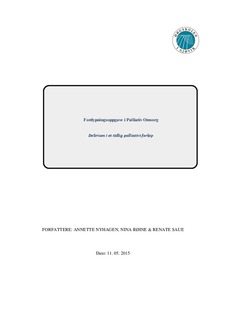| dc.contributor.author | Nyhagen, Annette | |
| dc.contributor.author | Røine, Nina | |
| dc.contributor.author | Saue, Renate | |
| dc.date.accessioned | 2015-06-23T06:54:27Z | |
| dc.date.available | 2015-06-23T06:54:27Z | |
| dc.date.issued | 2015 | |
| dc.identifier.uri | http://hdl.handle.net/11250/285352 | |
| dc.description.abstract | NORSK: Bakgrunn: Delirium er en av de hyppigste psykiatriske tilstandene i et palliativt forløp. Tilstanden er underkjent, og blir i mange tilfeller oversett av klinikere grunnet feiltolking av symptomer og sammenlikninger med andre tilstander.
Hensikt: Å skape et bredere fokus på hvordan spesialsykepleiere med økt kunnskap og forståelse kan gjenkjenne og forebygge delirium i en tidligere fase av det palliative forløpet.
Metode: Litteraturstudie er brukt som metode, der vi har innhentet ulik faglitteratur, samt vitenskapelige artikler som omhandler emnene delirium, pasienter med kreft, identifisering, forebygging og sykepleie erfaringer. Disse har vi hentet fra ulike databaser som Cinahl, Science Direct, PubMed og Sage Journals.
Funn: Sykepleiere samt annet helsepersonell har manglende grunnleggende kunnskaper om tilstanden. For å identifisere tilstanden må det benyttes ulike kartleggingsverktøy, men og det kliniske blikket til sykepleiere er en nødvendighet. Kommunikasjon blant helsepersonell seg i mellom, samt med pårørende er for dårlig, noe som kan bidra til at mange av symptomene ikke blir fanget opp tidsnok.
Konklusjon: Det er for lite kunnskap blant sykepleiere innenfor området delirium. Det er behov for mer utdanning og opplæring rundt tilstanden. Lite kommunikasjon og for lite fokus på det tverrfaglige samarbeidet er også faktorer som påvirker identifisering av delirium. | nb_NO |
| dc.description.abstract | ENGLISH: Background: Delirium is one of the most frequent psychiatric conditions in palliative care. The condition is little renowned, and is therefore often overlooked by clinicians due to misinterpretation of symptoms and comparison to other conditions.
Purpose: To create a wider focus on how specialist nurses with increased knowledge and understanding can recognize and prevent delirium in an earlier phase of the palliative proceeding.
Method: The method is a literature study. We have collected literature and scientific articles about delirium, cancer patients, identification, prevention and nurse experiences. We have collected the information from different databases; Cinahl, Science Direct, PubMed, and Sage Journals.
Results: Nurse and other health care professionals lack basic knowledge about the condition. We need different mapping approaches to identify the condition, but the clinical eye of a nurse is also of great importance. Communication between health care professionals, but also between health care professionals and relatives, is to poor. This will in time delay the process of developing a good overview of symptoms.
Conclusion: There is to little knowledge about delirium among nurses. There is a great need for more education and training about the condition. Lack of communication and focus on the interdisciplinary cooperation is also factors that affects the identification of delirium. | nb_NO |
| dc.language.iso | nob | nb_NO |
| dc.subject | palliasjon | nb_NO |
| dc.subject | delirium | nb_NO |
| dc.title | Delirium i et tidlig palliativt forløp | nb_NO |
| dc.title.alternative | Delirium in an early palliative stage | nb_NO |
| dc.type | Student paper, others | nb_NO |
| dc.subject.nsi | VDP::Medical disciplines: 700::Health sciences: 800::Nursing science: 808 | nb_NO |
| dc.source.pagenumber | 45 | nb_NO |
